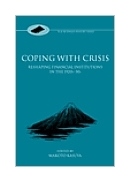|
||
podział tematyczny • wydawnictwa anglojęzyczne podział tematyczny Newsletter: • Zamów informacje o nowościach z wybranego tematu Informacje: • sposoby płatności i dostawy • kontakt • Cookies na stronie • Regulamin zakupów Napisz propresssp@gmail.com |
COPING WITH CRISIS INTERNATIONAL FINANCIAL INSTITUTIONSKASUYA M.wydawnictwo: OXFORD , rok wydania 2004, wydanie Icena netto: A comparative examination of financial institutions in the interwar period focusing on the UK, the US, Germany, France, and Japan. In this latest addition to the prestigious Fuji Business History series, the contributors to the volume analyse the ways in which different institutions coped with the financial crises at this time, and how they competed with each other. They also ask how this affected the financial climates of the countries in question. The discussion is divided into three parts: commercial banking, universal banking, and insurance and securities.
Table of Contents Makoto Kasuya: Introduction Part I: Commercial Banking 1 Youssef Cassis: European Bankers in the Interwar Years 2 Michael Collins: British Commercial Bank Support for the Business Sector and the Pressure for Change 3 Eugene White: The New Deal and Commercial Banking Lending 4 Shinji Ogura: Mitsui Bank's Lending Policy in Transition in the Interwar Years Part II: Universal Banking 5 Eric Bussiere: The French 'Banques d'Affaires' in the Interwar Period 6 Harald Wixforth: The German Banks and their Business Strategies inthe Weimar Republic: Preliminary results and new findings Part III: Insurance and Securities 7 Mariko Tatsuki: How Japanese Life Insurance Companies Coped with a Controlled Economy 8 Edwin Perkins: Growth Stocks for Middle-Class Investors: Merrill Lynch & Co., 1914-41 9 Makoto Kasuya: Securities Markets and a Securities Company in Interwar Japan: The case of Yamaichi 234 pages Księgarnia nie działa. Nie odpowiadamy na pytania i nie realizujemy zamówien. Do odwolania !. |


